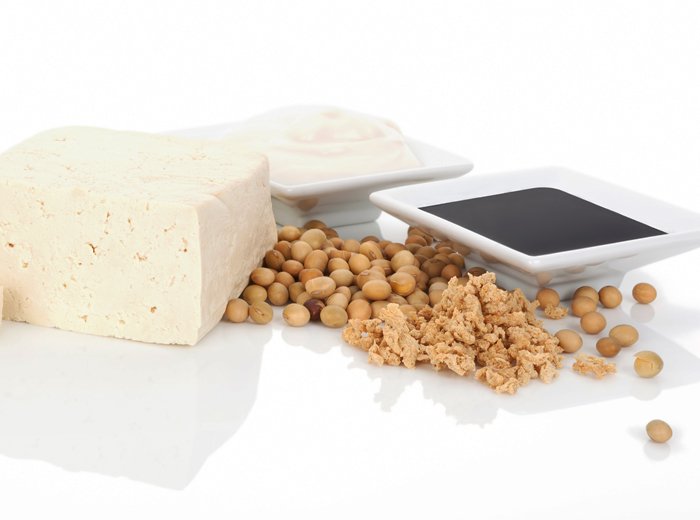Soybean Products from Traditional Use to Modern Applications
1324 Views |

นักวิชาการทั่วโลกกล่าวว่า ปัญหาความมั่นคงทางอาหาร เป็นสิ่งที่ผู้บริโภคควรตระหนัก และเนื่องจากปัญหานี้มีผลกระทบอย่างใหญ่หลวงต่อผู้บริโภคในอนาคต เราจึงต้องเร่งสร้างการเปลี่ยนแปลงเพื่อให้เกิดความยั่งยืนในการบริโภค ตั้งแต่อดีตจนถึงปัจจุบันมนุษย์บริโภคเนื้อสัตว์เพื่อใช้เป็นแหล่งของโปรตีน และสารอาหารอื่นๆ ด้วย แต่ด้วยอัตราการบริโภคในปัจจุบัน มีผู้คาดการณ์ว่าการผลิตเนื้อสัตว์จะไม่เพียงพอภายในปีพ.ศ. 2593 และความต้องการบริโภคเนื้อในช่วงเวลานั้นอาจจะมากถึง 460 - 570 ล้านตัน หรือเพิ่มขึ้นจากปีพ.ศ. 2551 ถึง 2 เท่า1 ทั้งนี้ ความต้องการผลิตภัณฑ์จากสัตว์และการบริโภคเนื้อสัตว์ที่เพิ่มสูงขึ้น ยังส่งผลกระทบต่อสิ่งแวดล้อม พื้นดิน พื้นน้ำ ก่อให้เกิดมลพิษ ก๊าซเรือนกระจก และเป็นภัยต่อความหลากหลายทางชีวภาพอีกด้วย คณะกรรมการอีเอทีแลนเซ็ท (EAT-Lancet Commission) เปิดเผยว่าหากผู้บริโภคหันมาบริโภคอาหารจากพืชมากขึ้น จะสามารถลดการทำลายสิ่งแวดล้อมจากการทำปศุสัตว์ได้ถึงร้อยละ 80 จากประเด็นดังกล่าวทำให้ผลิตภัณฑ์จากโปรตีนทางเลือกที่มีรสชาติ เนื้อสัมผัส และสารอาหารคล้ายกับเนื้อสัตว์มีมากขึ้นในท้องตลาด การระบาดของโควิด-19 ในช่วงที่ผ่านมาก็มีส่วนทำให้ผู้บริโภคหันมาสนใจอาหารเพื่อสุขภาพมากขึ้นด้วยเช่นกัน จากการศึกษาภาระโรคในระดับนานาชาติ (Global Burden of Disease: GBD) พบว่าในประเทศสหรัฐอเมริกา การได้รับสารอาหารในปริมาณที่เหมาะสมมีส่วนช่วยลดอัตราการเสียชีวิตจากโรคหัวใจและหลอดเลือดลงครึ่งหนึ่ง โดยเฉพาะการรับประทานอาหารจากพืช สามารถช่วยลดความเสี่ยงของการเกิดโรคอ้วน โรคเบาหวานชนิดที่ 2 และโรคหัวใจได้ ทั้งยังช่วยลดความเสี่ยงต่อการเจ็บป่วยรุนแรง และเสียชีวิตจากโควิด-19 อาหารจากพืชไม่ใช่เรื่องใหม่ เรารับประทานอาหารจากโปรตีนทางเลือกจากพืชแทนการบริโภคโปรตีนจากเนื้อสัตว์มายาวนานแล้ว ยกตัวอย่างเช่น นมจากถั่วเหลือง อาหารท้องถิ่นของประเทศจีนที่คิดค้นโดยฮานยิ เมื่อ 1700 ปีก่อนคริสต์ศักราช หลังจากนั้นก็มีการบริโภคอย่างกว้างขวางในสมัยราชวงศ์ชิง และเผยแพร่ไปยังประเทศญี่ปุ่น เกาหลี สหรัฐอเมริกา และอีกหลายประเทศทั่วโลก เพราะเป็นนมจากพืช และถั่วเหลืองก็ยังสามารถนำไปใช้แปรรูปเป็นผลิตภัณฑ์อื่นได้ด้วย อาทิ ซอสถั่วเหลือง และเต้าหู้
According to global experts, food security is a critical issue with severe consequences in the future, and therefore, reformation is urgently required to sustain our food consumption. From the beginning of human civilization, meat has played a vital role in acquiring proteins and other nutrients. But rather alarmingly, at current and projected consumption rates, meat production will be insufficient by 2050. By that time, global meat consumption is expected to reach between 460 million and 570 million tons, or roughly twice as much as in 20081. Moreover, the high demand for animal products and increased consumption also pose a great risk to the environment, including land, water, pollution, greenhouse gas emissions, and endangering biodiversity. According to the EAT-Lancet Commission, eating more plant-based foods could reduce emissions from livestock production by up to 80%. As a result of that, the market for nutritional protein alternatives with comparable taste and texture has grown rapidly. Especially during the COVID-19 pandemic, when many consumers became increasingly concerned about maintaining a healthy diet and chose to eat plant-based foods instead. As per the Global Burden of Disease study, proper nutrition may help prevent nearly half of the cardio-metabolic deaths in the US. A plant-based diet, in particular, seems to reduce all-cause mortality and the risk of obesity, type 2 diabetes, and coronary heart disease, partly by effectively improving nutrient intake, and thereby solving the underlying health conditions that put our population at such a high risk of severe COVID mortality and morbidity.Plant-based is nothing new. The concept of animal product alternatives as protein sources has existed since ancient times, with traditional products such as soy milk. Soy milk was invented in China by Han Yi (1700 BC) and was extensively consumed throughout the Qing dynasty before spreading to Japan, Korea, the United States, and all over the world. It is one of the most popular non-diary milks right now. In addition to soy milk, soybeans can also be processed into other products such as soy sauce and tofu.



